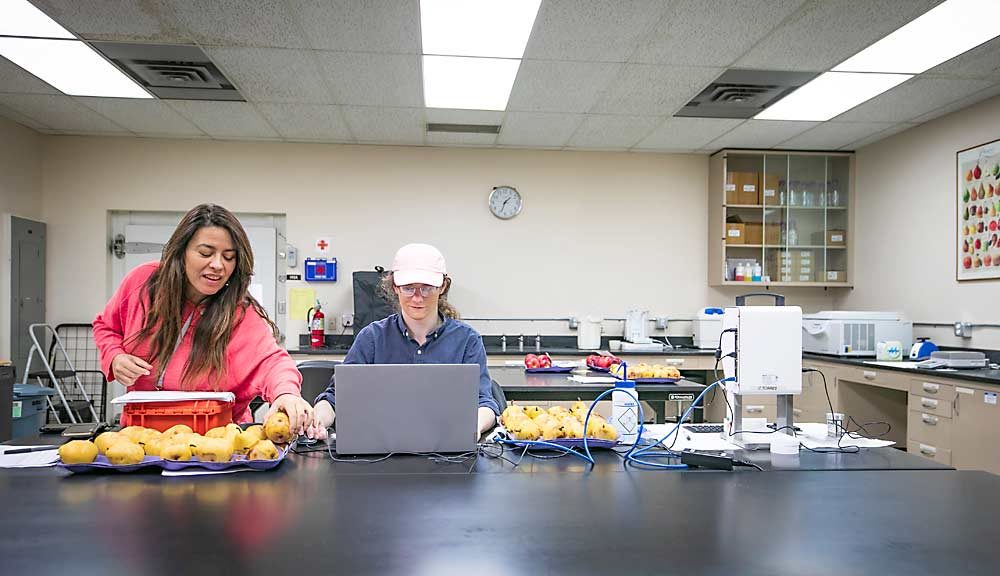Precision harvest and optimized storage plans for pome fruit rely on various indicators of fruit maturity, but an unusually warm growing season can throw off those critical signals.
That’s an important complexity for growers and packers to be aware of as climate change introduces more warm seasons and more variability, said Carolina Torres, the endowed chair for postharvest physiology at Washington State University. In a talk at the Washington State Tree Fruit Association’s Annual Meeting in December, Torres explained how seasonal climate impacts the way fruit performs in the cold chain after harvest.
“When we are facing a warm season, we know that, we just harvest earlier with the indices we usually use,” she said, citing starch scales, color and firmness as the common indicators of maturity. “We think everything is going to be fine, but that fruit is going to soften much faster in storage.”

Warmer-than-usual weather at harvest means fruit is ripening rapidly, and that pace remains higher in storage than with fruit grown in a more normal season, even with controlled atmosphere regimes slowing everything down, she said. That matters most for organic apples and pears.
“It’s not relevant when you put 1-MCP on the fruit, but without it, you can’t expect the same results in a warm season when you harvest with the same maturity indices,” she said. “In organic, you really have to nail down what you are dealing with every single year.”
In recent years, Washington warehouses have reported some unusual Gala disorders that are more common in warmer growing regions such as Brazil, said David Rudell, a scientist with the U.S. Department of Agriculture’s Agricultural Research Service Lab in Wenatchee.
The problem stems from growers waiting to harvest until the apples develop good red color, but in an unusually warm season, fruit is more mature by the time it gets red, he said. Then, the fruit experiences even more of a temperature shock when it goes from a hot orchard to cold storage — and the stress of that transition can trigger disorders as well.
“This is what we can expect from climate change,” he said.
Better tools for assessing maturity and disorder risk, based directly on fruit biomarkers, will help. The indices the industry uses today vary due to climate, crop load, tree vigor, nutrition and, of course, cultivar, Torres said.
“All of these maturity indices have different sensitivities and dependency to ethylene,” she said. That’s why, in unusual growing conditions, measures that usually align, such as starch and color, can end up quite out of sync.
Torres shared insights from research conducted in Chile during her previous position as a faculty scientist at the University of Talca. She looked at the apple cultivar Galaxy, growing on Malling 9 rootstocks in the central valley region, which tends to be hot and dry, and compared fruit grown in average years with fruit grown in years with periods of heat and low humidity, or about 30 percent more stressful growing periods.
Fruit grown in the more stressful seasons lost up to 2.5 pounds of firmness per month in cold storage, compared to 1 pound in normal seasons, Torres said. She plans to repeat this approach with a four-year study in Washington orchards, funded by the Washington Tree Fruit Research Commission.
“We see this a lot in Chile,” she said. “In a hot and dry environment, there is a profound effect of this on fruit quality.”
Another example she shared: Cripps Pink grown in Chile are prone to internal browning development after months in storage. Growers hang the fruit too long because they are waiting to get good color, which puts it at risk. But she found that stepwise cooling — conditioning — plus 1-MCP application reduced the incidence. However, the treatment did not perform consistently; some orchards were just more susceptible, she said.
Understanding in more detail how each growing season’s conditions impact fruit behavior in storage will help Washington’s tree fruit industry adapt to climate change and improve packout. Research by Torres, Rudell and others aims to help provide that information in the future.
“This was a cool fall, so the fruit should have good legs, it’s not very stressed,” Torres said in an earlier interview. “But we can’t rely on weather like this.” •
—by Kate Prengaman






Leave A Comment